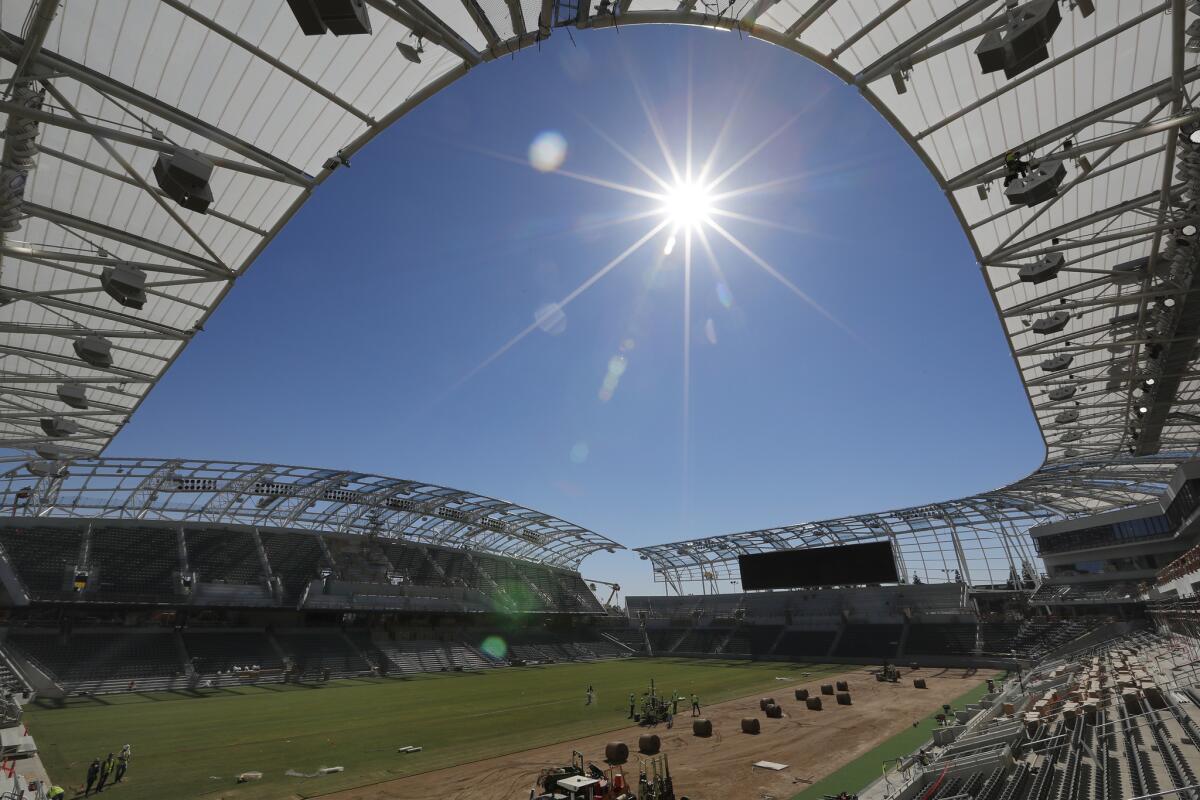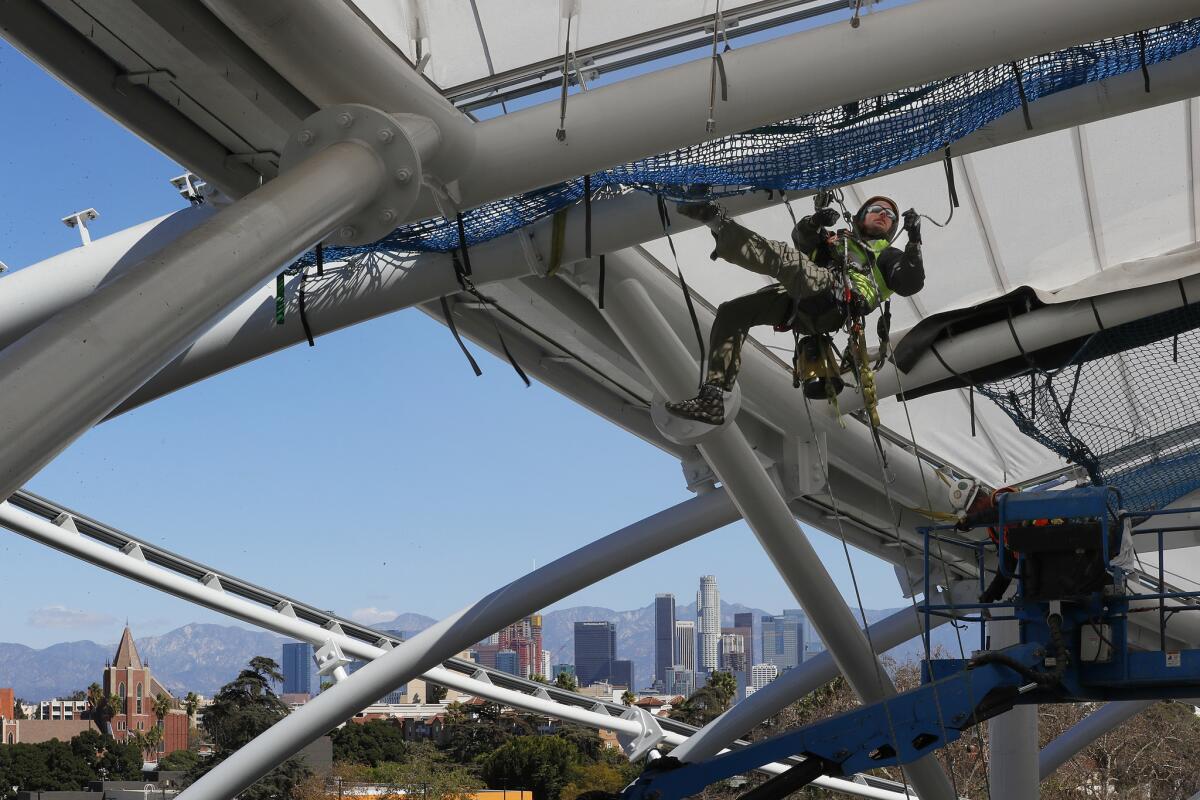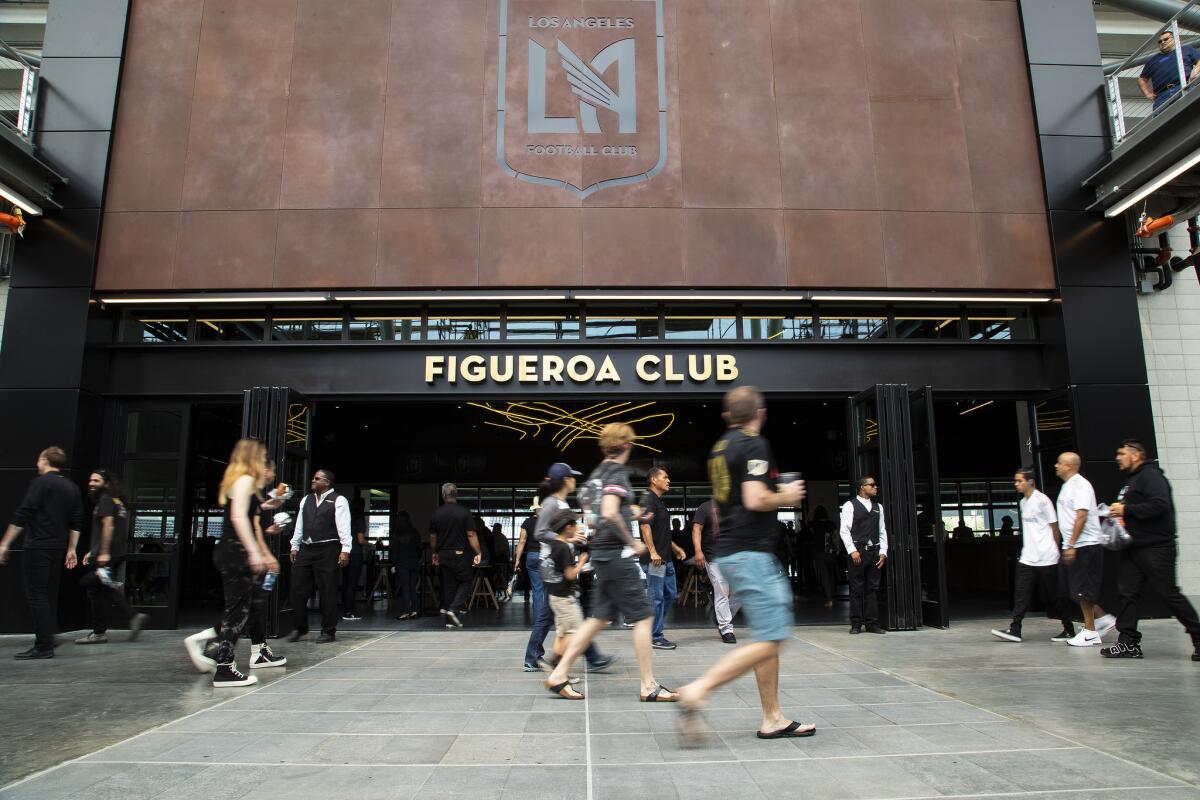Must Reads: How LAFC rose from the ashes of Chivas USA and aims to be the team of Los Angeles
- Share via
A few months after the Los Angeles Football Club was birthed during a red-carpet ceremony held in a dark, stuffy movie studio on Sunset Boulevard, a cross-section of the ownership group met at chairman Peter Guber’s Bel-Air home to hammer out a vision for the infant club.
“Real formative stuff,” team president Tom Penn, who organized the retreat, remembered of the discussion. “If you get it right, it helps with everything else.”
More than three years later, a major part of that vision will come into focus when LAFC plays the first home game in its history Sunday at Banc of California Stadium, its new $350-million home in the shadow of the Coliseum in Exposition Park.
In many ways the 22,000-seat soccer-specific stadium has come to define both the club and its complexities. The stadium is modern and luxurious, but was built in the city’s gritty core. It’s sleek and handsome, but it shares a parking lot with a concrete building constructed two decades before World War II.
That’s consistent with a team that is both new and old, rich and poor, glamorous and plain.
“We are not a suburban team. We are not a beach team,” Penn said. “We’re brick and mortar. We’re downtown L.A.
“We’re embracing and celebrating the fact that we’re of the city itself.”
We are not a suburban team. We are not a beach team. We’re brick and mortar. We’re downtown L.A.”
— Tom Penn, LAFC president
So is the stadium. Built on land where the Sports Arena once stood, the building was LAFC’s first real heartbeat and the final brick in its development, merging an idea first offered by MLS commissioner Don Garber nearly a decade ago with a dream shared by Guber, Penn and the rest of the team’s owners.
“We had our sights on the Sports Arena for four or five years before we even contemplated LAFC,” said Garber who, as commissioner, has spearheaded a movement that has seen 18 of the 23 MLS clubs complete or start work on soccer-specific arenas.
“We knew there were certain zoning benefits to having this become a soccer stadium. And in our first discussions with Peter Guber we wanted them to focus on this site.”
How Guber wound up in position to make that call requires a bit more explanation.
MLS was the country’s fastest growing professional sports league when Ruben Gnanalingam, a Malaysian who owned parts of several sports franchises including the English soccer club Queens Park Rangers, attended a summit of like-minded investors organized by Penn. A year later, Gnanalingam returned to the event with Henry Nguyen, a Vietnamese American entrepreneur.
Nguyen went to Penn with the idea of buying into MLS with Gnanalingam and Vincent Tan, another Malaysian who owned an English soccer club, and the group approached the league with their plan. The group wanted to be in a major market but Southern California had two teams, New York was adding a second and Chicago, Dallas, Houston, Boston, Seattle and Philadelphia were all full.
But the group caught a break in the winter of 2014 when the league bought the failing Chivas USA franchise from Mexican owner Jorge Vergara with plans to sell the team on the promise the new investors kept it in Southern California. To be considered, the league told the Penn group it needed to add a local partner.
Enter Guber, CEO of Mandalay Entertainment, a film and television production company, and a co-owner of the Dodgers and Golden State Warriors.
“The dream local partner,” Penn says.
The group continued to add celebrity partners — World Cup champion Mia Hamm Garciaparra and her baseball-star husband Nomar Garciaparra, basketball Hall of Famer Magic Johnson and self-help author Tony Robbins, among others — until it had the cash and the clout to land a $110-million bid to replace Chivas USA with a brand-new MLS franchise.
Four days after Chivas USA played its last game, Garber strode down the red carpet on Sunset Boulevard to welcome LAFC to the league. And that’s when the real work started.
“When you look at LAFC, there was nothing there,” Guber said. “There wasn’t even a hole in the ground. There was no name for the team. There were no players, there was no staff, there were no executives. There was nothing. Nada, nothing, zip, zero. Except a big check we had to write.
“The vision was ‘build it and they will come.’ You build the right kind of relationship with your audience, build a product that has value, hopefully they will come.”
The vision was ‘build it and they will come.’ You build the right kind of relationship with your audience, ... hopefully they will come.”
— Peter Guber, LAFC chairman

If Penn was the organizer, Guber was the visionary, the guy who found success where others barely spotted opportunity. His films have earned 50 Academy Award nominations. He had an idea to put the 1984 Olympics to music and the soundtrack to the Games won a Grammy. His Warriors have claimed two of the last three NBA titles and the Dodgers reached the World Series last season for the first time in nearly three decades.
His vision for his soccer club was the same one Garber and MLS has pushed — with little success — with Chivas USA: a new stadium, in the heart of the city, served by public transportation. This time, ownership was listening.
“We said, ‘You know something? Downtown’s happening,’” Guber said. “We want to be downtown. We want to be of the city, in the city, at the city. And try to build it from that point up.
“But you do those things, you take chances.”

Even by Guber’s gilded standards, few gambles had paid off as big as Banc of California Stadium, the most expensive soccer-specific facility in MLS history.
“Peter Guber doesn’t get enough credit for what has come together here, from the first conversation in wiring together an ownership group,” Garber, the league commissioner, said. “In a very quintessential Hollywood way, this stadium does feel like it is a place where dreams can be made.
“There are a lot of people that have been involved in this, but his pixie dust is spread throughout this building. It has a special magic to it that came out of Peter’s vision and creativity.”
Nearly six years after his first conversation with Nguyen and more than three years after that introductory news conference on Sunset Boulevard, Penn leaned back in a chair in the spacious directors lounge at Banc of California Stadium. On the stadium’s massive video boards he had just watched LAFC win its fourth game in six tries, a historic start for an expansion team and one that will see it enter Sunday’s home opener tied for second in the Western Conference standings.
“Sometimes it feels like it’s been forever,” he said of the journey. “And sometimes it feels like it was yesterday.”


The stadium, he said, was everything he imagined it would be. The team is better than he thought possible less than two months into its first season. So the day before he had presided over a companywide staff meeting in which he said it was time the organization joined the players in moving beyond the promises, the possibilities and the pledges. Now, he said, it was time to deliver on those expectations.
Monty Stevenson, a LAFC supporter looking out at the stadium from a level below Penn’s suite, agreed.
“We’re very spoiled in a way,” he said. “I hope and pray that the club matches what they’ve built: Their ambition [and] just the level of how far they’ve taken this stadium.”
Follow Kevin Baxter on Twitter @kbaxter11
Go beyond the scoreboard
Get the latest on L.A.'s teams in the daily Sports Report newsletter.
You may occasionally receive promotional content from the Los Angeles Times.




